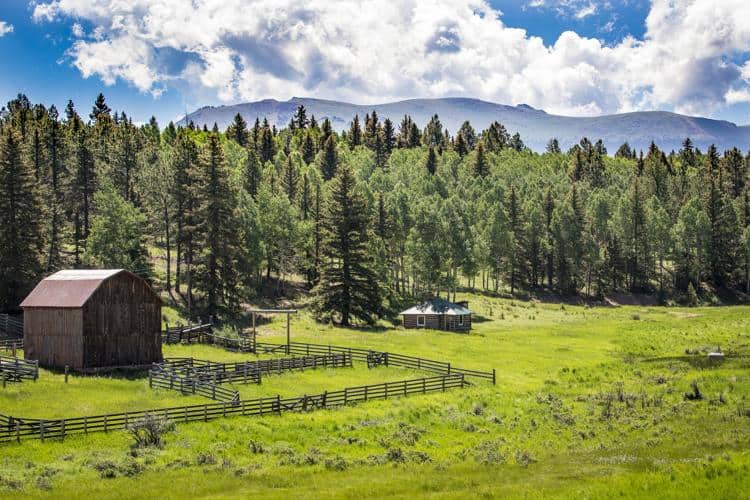
Russ Frisinger, photo
This from the Wall Street Journal via the Colorado Springs Gazette. Seems like a win-win for conservation organizations to buy these and allow the kinds of activities and recreation they would like (or not) without conflicts. Less conflict, more conservation..
Now, as those John Wayne-loving baby boomers age out of the lifestyle or die, they or their children are looking to sell those trophy properties.
That generational changing of the guard has led to an oversupply of ultraluxury ranches on the market. Nowhere is the glut more apparent than in Colorado, where some of the biggest and most storied properties are located.
Jeff Buerger, a local ranch broker with Hall & Hall in Colorado, said there are more large trophy ranches on the market right now than he can recall in his nearly three decades in the business. There are about 20 ranches priced at over $20 million on the market in the state, according to a Wall Street Journal analysis of listings.
Some of Colorado’s most prominent listings include a nearly 12,000-acre ranch near Meeker, owned by retired professional golfer Greg Norman, which has been for sale since 2011; it is listed for $50 million. Henry Kravis, the billionaire co-founder of private-equity giant KKR, put his Colorado ranch, known as Westlands, on the market for $46 million in January. Discovery Channel founder John Hendricks relisted his ranch near the Utah border, plus an adjacent resort, for $279 million in May. (He and his wife, Maureen Hendricks, first put the property on the market for $149 million two years ago; that price didn’t include the resort.
Despite a strong local economy, buoyed by tourism, the aerospace industry and the cannabis industry, the surge in supply has led to a lack of urgency from buyers — and is putting downward pressure on prices. Some ranches have sat on the market for years. “Savvy investors… take their time to compare and contrast. They get analysis paralysis,” Buerger said.
For the children of ranchers, the Wild West doesn’t always have the same draw as it had for their parents. Ranch operations are labor intensive, and keeping up with costs can be a struggle. And grandchildren would often rather play videogames and hang out with their friends than go fly-fishing in the wilderness.
“If you look back in the day to the ’70s and ’80s, there were these guys … raised with this mythology of the West,” said Ken Mirr, a local ranch broker. “It was attachment to something Hollywood produced. Their children aren’t necessarily always as interested in operating the properties. Sometimes the kids just see cows and think ‘What should I do with this?’”
Many of the ranches have sprawling mountainous landscapes, forests, meadows, rivers, fisheries and big-game-hunting facilities. Kravis’s has its own golf course. Operating costs vary dramatically, depending on how much infrastructure ranchers have on their land and the level of agricultural activity but can often be millions a year.
And ranching is an increasingly tough business. The increasing expense of upkeep and infrastructure, coupled with the declining price of beef, is squeezing ranchers on both ends, experts said.
“I know a lot of multimillionaires who run cattle and still lose millions of dollars a year,” said Tony Caligiuri of Colorado Open Lands, a land-conservancy group. “One guy I talked to recently in oil and gas said he’s hoping to get his loss down to $1 million a year. His ranch hasn’t turned a profit the whole time he owned it.” In some ways, wealthy ranchers who can afford losses are keeping the industry afloat, Caligiuri said.
Unlike other sectors of the U.S. high-end real-estate market, ranches can’t fall back on international purchasers. Broker Tim Murphy said there is virtually no demand for ranches from international buyers, many of whom “don’t get it.”
For ultrawealthy out-of-town owners, these ranches are frequently geared toward fishing and hunting. But some want the experience of actually herding cattle and plowing fields — and often face lower property taxes if they engage in agricultural activities. Others lease some of their land to local ranchers. “They have high-stress, fast-paced lives,” Belton said. “When they can spend some time going around and around on a tractor, it’s cathartic.”
As the cowboy romance fades, sellers are also trying a new tack: targeting conservationists.
“The last wave of buyers was the baby boomers who fell in love with John Wayne and wanted that experience for themselves,” Buerger said. “Today, it’s more about conservation. You’re starting to hear more landowners talking about wildlife habitat enhancement and ecological work.” Other targeted groups include wealthy families from the East Coast or Silicon Valley.
To fans of “Practice of Science Friday,” that feature will return next week.
Putting conservation easements on them would make them even more affordable (with some financial benefits to owners, though they have been controversial lately in Colorado). If they are close to public lands, using conservation easements to prevent development could ease future WUI conflicts (so I hope the Forest Service Forest Legacy program is paying attention; I don’t know if BLM has anything similar). There could also be opportunities for securing better access to federal lands where ranches are adjacent.